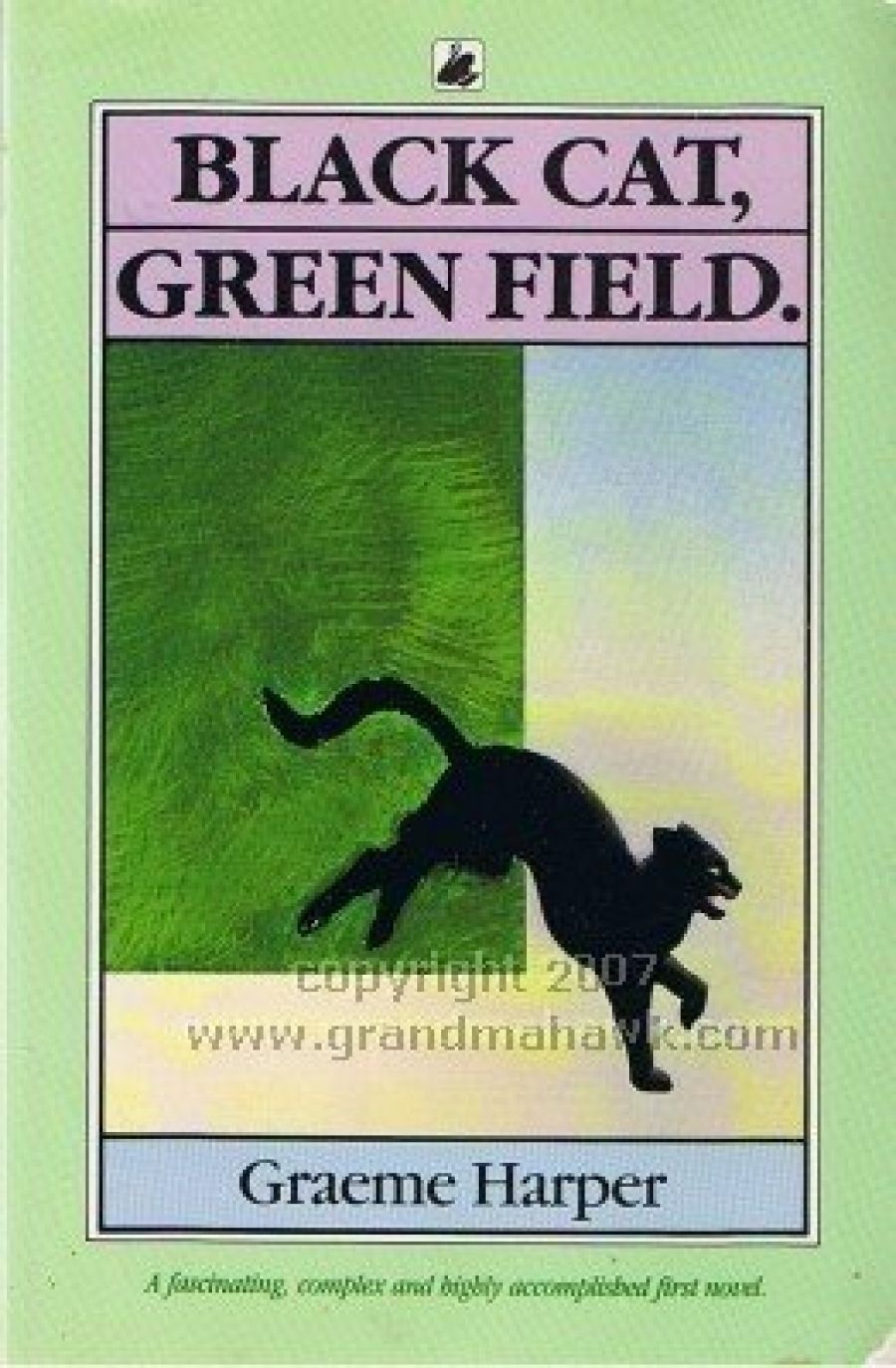
- Free Article: No
- Contents Category: Australian Fiction
- Custom Article Title: Andrew Peek reviews 'Black Cat, Green Field' by Graeme Harper
- Review Article: Yes
- Article Title: Hardy and New South Wales
- Online Only: No
- Custom Highlight Text:
Set in New South Wales during the turbulent years of 1916–19, Graeme Harper’s Black Cat, Green Field evokes the period with particularity and jaggedness. The first of the novel’s five parts introduces the central character: Sidney Nelson, recently wounded in Gallipoli, and now living in Sydney. A former art student, he is yearningly aware he could instead have been in the Paris of Picasso and Gris. He is also a ‘black cat’, a supporter of the radical industrial Workers of the World and when, in the closing months of 1916, the ‘Twelve’ I.W.W. members are sent to prison and police harassment intensifies, the organization goes underground and Nelson loses friends and contacts. Feeling jaded and devoid of artistic inspiration, he decides to leave Sydney and, after a false start, moves up to the north coast of NSW to stay near his sister May. The ‘black cat’ is going to paint the ‘green field’.
- Book 1 Title: Black Cat, Green Field
- Book 1 Biblio: Black Swan, 389 pp, $12.95 pb
The next four parts of the novel focus upon the entanglements that bind the Nelson family with the family into which May Nelson has married, the Camerons. It becomes apparent that this marriage is not the only point of connection and various mysteries are identified in the history of this dual family saga. When Sidney is piecing together his past experiences with his father and sister, in retrospective passages lurking in the main narrative, there is a strong sense of a young man facing up to haunting, disturbing elements in his life. This has much more substance than coincidences surrounding mistresses and legal cases which are resolved in a page and a half’s rapid summation near the close with the sort of convoluted tidiness reminiscent of Hardy or Dickens. What we are left with, beyond the memories, manipulation and coincidence, is a bond finally understood between Nelson and his brother-in-law, Dallas Cameron, arising from the sombre experience of history and skilfully meshing fiction and actuality.
Him and Dallas; returned from the war. Seeing the men left behind … Left, knee deep in foreign mud. He’d made it rest on [his father] Hugh Nelson; the guilt he felt. For Dallas there had been no escape. He was to do penance by extending the life of the one man for whom he had continued responsibility, his father.
Freed at last from his responsibility and guilt, Nelson, whose sight has earlier been seriously impaired in a flood, leaves Australia to spend time in the beloved Paris of his youthful imagination, an ironic variation on the Return of the Native theme. With Hardy epigraphs to each part of the novel and its concern with provincialism, rural ritual and rural society in transition, there is more than a touch of this English writer about Harper’s novel.
Black Cat, Green Field is distinguished by an artful anachronistic quality appropriate to its setting in time and place, deriving from the episodic construction, snappy dialogue, and use of a narrative voice that is brisk and plain-dealing. The novel moves between the subjective and objective rendering of experience, defined, for instance, in Nelson’s perceived contrast between artist and author:
The artist is allowed to touch the viewer’s ‘insides’, as Verna Lewers would say. The author must give straight answers. It is a poor author who deludes his readers.
The most impressive thing about Black Cat, Green Field is Harper’s success at capturing atmosphere and a sense of location, particularly in relation to the northern New South Wales of the period. The following extract is one example of this. It deals with the business of clearing land around the end of the War.
It was not strictly illegal to offer work to Germans. It was just that few would work with them. The blacks were not fussed, they’d worked with far worse.
‘He pay us no wage,’ said Athol.
Karl Muller nodded. ‘A poor wage. But there is work until property is cleared.’
‘So he can put on more cattle?’ said Sidney.
Karl shook his head. ‘To sell.’ Sidney must have appeared surprised because the old German jumped quickly to explain. ‘Mr. Cameron’s men draw out plans. Mr. Cameron says we must stay quiet or they know we are Germans and he put us off.’
‘It’s all good timber,’ said Athol. ‘Cedar, blackbutt, beech.’
Within his beard Karl kept tiny tobacco stained teeth. He slapped his son’s thigh.
‘My son a cabinet-maker. Geschaftsmann! Craftsman!’ He look at wood with green eyes.
It is striking how much information has been deftly and economically included here, and whilst the mode is narrative not didactic, we are prompted to consider the wastefulness of the clearing of the land, the role of those forced into doing it, and the selfish and short-sighted economic reasons involved.
This strength is also a liability. For there is a tendency for the rich local detail, profusion of minor characters and episodes to obscure narrative design. There are unfortunate and mawkish moments in the relating of the narrative.
When his sister came back into the Church Les decided she’d been fucked. Everyone cheered, cheered her for having done it. His uncle Dal led the hymns.
However, it remains a novel distinguished by its breadth of vision, generous proportions, its inquisitiveness about the nature and value of artistic experience and political commitment and its desire to confront history through fiction.


Comments powered by CComment